The electric vehicle motor market is estimated at USD 102.8 billion in 2025 and is projected to reach USD 691.9 billion by 2035, expanding at a CAGR of 21.0% during the forecast period. The electric vehicle (EV) motor market is witnessing substantial growth, driven by the accelerating adoption of electric mobility solutions worldwide. Rising concerns over environmental pollution, stringent emission regulations, and government incentives for clean energy transportation are contributing to increased demand for high-performance EV motors. Technological advancements in motor design, power efficiency, and thermal management are enhancing vehicle range and reliability while reducing energy losses.
The market is further supported by increasing investments from automakers and battery manufacturers in next-generation EV platforms, with a focus on optimizing powertrain efficiency and reducing production costs. Growing consumer awareness regarding sustainable transportation and the expansion of charging infrastructure are also fueling adoption.
Additionally, innovations in materials, motor control software, and integration with battery management systems are improving overall performance As the EV industry continues to mature, demand for motors capable of supporting higher power outputs, improved efficiency, and compatibility with diverse EV types is expected to sustain market growth, positioning electric motors as a critical component of future mobility solutions.
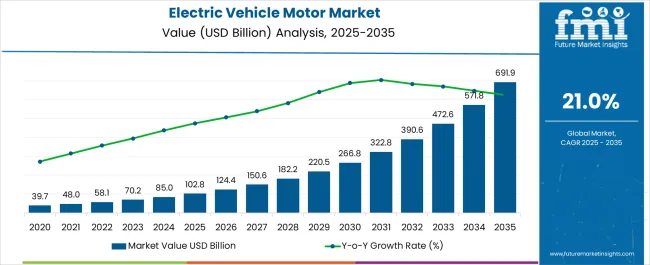
| Metric | Value |
|---|---|
| Electric Vehicle Motor Market Estimated Value in (2025 E) | USD 102.8 billion |
| Electric Vehicle Motor Market Forecast Value in (2035 F) | USD 691.9 billion |
| Forecast CAGR (2025 to 2035) | 21.0% |
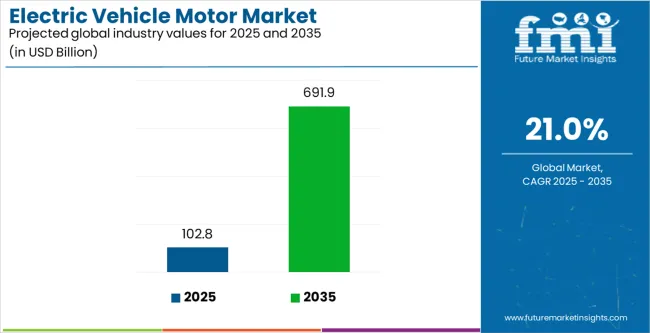
The market is segmented by Product Type, Power Capacity, and EV Type and region. By Product Type, the market is divided into Alternating Current (AC) and Direct Current (DC). In terms of Power Capacity, the market is classified into Above 200kW, Up To 100kW, and 101 To 200kW. Based on EV Type, the market is segmented into Battery Electric Vehicle (BEV), Hybrid Electric Vehicle (HEV), and Plug-In Hybrid Electric Vehicle (PHEV). Regionally, the market is classified into North America, Latin America, Western Europe, Eastern Europe, Balkan & Baltic Countries, Russia & Belarus, Central Asia, East Asia, South Asia & Pacific, and the Middle East & Africa.
The alternating current (AC) motor segment is projected to hold 83.8% of the market revenue in 2025, establishing it as the leading product type. Growth is being driven by the widespread adoption of AC motors due to their higher efficiency, durability, and adaptability in various EV architectures. These motors provide superior torque control, energy regeneration capabilities, and better performance under varying load conditions, making them suitable for passenger vehicles, commercial EVs, and high-performance applications.
The compatibility of AC motors with existing power electronics and inverter technologies enhances integration efficiency and reduces production costs. Continuous advancements in magnetic materials, cooling technologies, and motor control algorithms have further improved efficiency, reliability, and lifespan, reinforcing preference among OEMs.
Increasing demand for scalable, high-performance motor solutions in battery electric vehicles and hybrid systems is expected to sustain leadership of AC motors Their ability to balance performance, efficiency, and cost-effectiveness positions them as the primary choice for automakers across global EV markets.
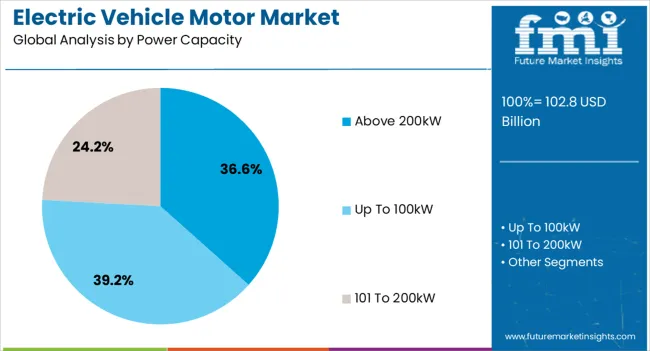
The above 200kW power capacity segment is anticipated to account for 36.6% of the market revenue in 2025, making it the leading power category. Growth is being driven by the demand for high-performance electric vehicles that require motors capable of delivering higher power output while maintaining efficiency and reliability.
Motors in this capacity range are suitable for premium passenger vehicles, sports EVs, and commercial applications that demand rapid acceleration and heavy-duty operation. Advanced thermal management, efficient cooling systems, and optimized magnetic design enable these motors to handle high loads without compromising performance or durability.
The segment is further supported by increasing investments in high-power battery systems and EV platforms designed to support long-range and high-speed operations As consumer expectations for performance, range, and efficiency continue to rise, demand for motors above 200kW is expected to remain strong, reinforcing the leadership of this power capacity category in the EV motor market.
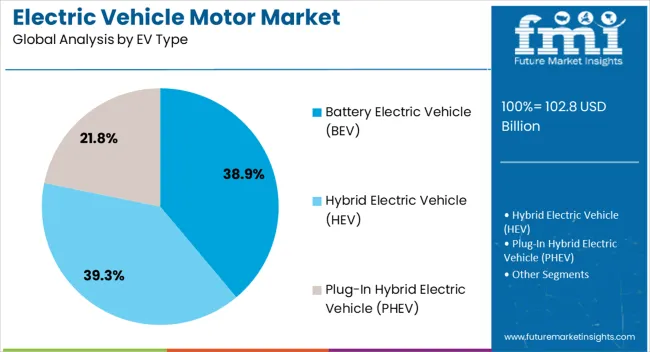
The battery electric vehicle (BEV) segment is projected to hold 38.9% of the market revenue in 2025, establishing it as the leading EV type. Growth in this segment is being driven by the global push for zero-emission transportation and increasing adoption of fully electric mobility solutions. BEVs rely entirely on electric powertrains, making high-efficiency motors critical for maximizing driving range and vehicle performance.
Technological advancements in motor design, power electronics, and integration with battery management systems have enhanced energy utilization and reliability, strengthening the appeal of BEVs among consumers and fleet operators. Government incentives, expanding charging infrastructure, and growing environmental awareness are further accelerating adoption.
As automakers continue to develop longer-range, higher-performance BEVs, demand for efficient and scalable electric motors is expected to sustain growth The BEV segment’s reliance on advanced motor technologies underscores its position as the primary driver of market expansion, supported by global electrification trends and increasing investments in sustainable transportation solutions.
The global electric vehicle motor market was valued at USD 33,370.99 million in 2020. From 2020 to 2025, demand for electric vehicle motors increased at an impressive 20.1% CAGR despite the challenges observed during the pandemic years. The overall market value was about USD 70,172.44 million in 2025.
During this period several government authorities started providing subsidies and incentives for the adoption of electric vehicles to stay in line with emission control norms. For example, the Chinese government invested about USD 600 billion to promote electric vehicles and the Indian government abolished regulations that hiked the price of electric vehicles.
| Attributes | Details |
|---|---|
| Electric Vehicle Motor Market Value (2020) | USD 33,370.99 million |
| Market Revenue (2025) | USD 70,172.44 million |
| Market Historical Growth Rate (CAGR 2020 to 2025) | 20.1% CAGR |
Manufacturers of EVs are now integrating AC synchronous motors with brushed current excitation. Until now it was widely believed that brushless motors were the only practical choice for an electric vehicle. For instance, with the inclusion of brushed current-excited AC synchronous motors in the new i4 and iX, BMW has preserved the impact of electric vehicle propulsion on the market.
Despite the flourishing electric vehicle motor market size, the lower replacement rates are anticipated to negatively impact the aftermarket. Typically the life of electric vehicle motors is between 15 and 20 years.
However, certain motors available in the automotive market have a lifetime operational efficiency that reduces the need for replacement. Also, in emerging and price-sensitive nations, electric vehicle motor sales are constrained by higher prices and maintenance costs of EVs.
The table below lists the regional markets with favorable opportunities for electric vehicle traction motor market growth.
| Regional Market Comparison | CAGR (2025 to 2035) |
|---|---|
| United States | 20.2% |
| Germany | 20.1% |
| United Kingdom | 20.9% |
| Japan | 22.7% |
| India | 20.9% |
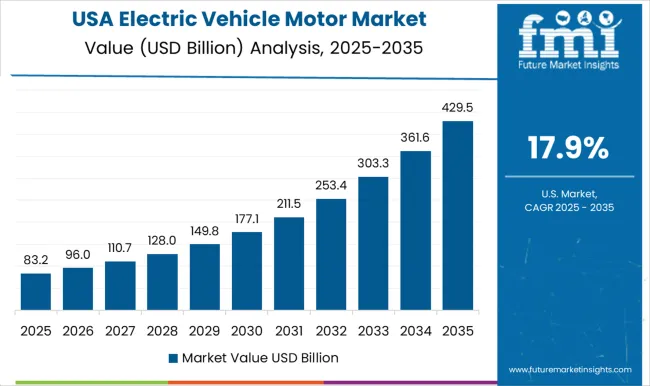
The United States held around 91% of the North American electric vehicle motor market in 2025. The market is set to lose 162 BPS points by 2035, following a CAGR of 20.2% over the projected years.
The United States electric vehicle drive system market is falling behind that of other emerging nations in Asia. However, favorable regulations to promote EV uses are likely to continue to have a positive impact on EV motor production and sales in the coming days. The United States is home to technologically advanced research institutes catering to the development of electric vehicles and the evolution of the modern electric vehicle motor market.
Electric vehicle motor market sales in the United Kingdom are increasing promisingly and could exhibit a 20.9% CAGR through 2035.
The United Kingdom is currently the most lucrative electric vehicle motor market in Europe owing to high EV sales. National sales targets, municipal air-quality targets, and favorable laws support domestic production of EVs and emerging trends in EV motor technology.
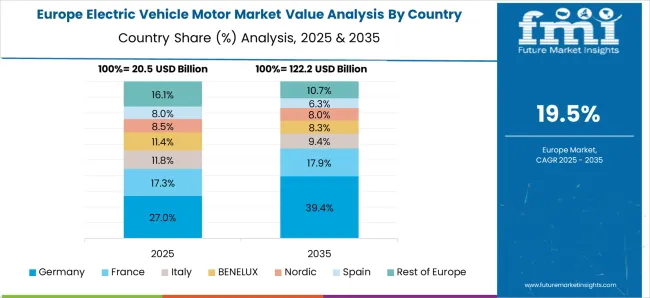
Over the forecast period, sales of electric vehicle motors in Germany are expected to grow at a CAGR of 20.1%. By the end of 2035, total sales of EV motors in the country are projected to grow by 6.2x.
The transition to more electric vehicles on German roadways is expected to be accelerated by the subsidies for buying an all-electric vehicle. Subsidies are available up to a maximum of USD 9,781.5. For plug-in hybrid vehicles, the assistance might reach USD 7336.
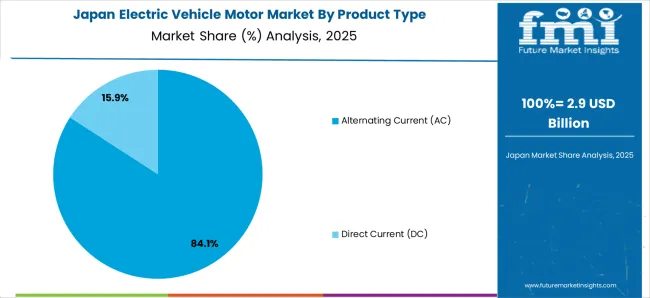
Japan is projected to create a substantial incremental opportunity for its electric vehicle motor manufacturers by registering a CAGR of 22.7% through 2035.
Due to a notable expansion of Japan’s automotive sector, the industry participants, like Toyota or Honda, are aiming to increase their production of electric vehicles. As a result, Japan’s electric propulsion system market is increasing in size having a positive impact on electric vehicle motor sales.
India is emerging as a promising market for electric vehicle motor manufacturers with an anticipated CAGR of 20.9% from 2025 to 2035.
The Indian government has implemented laws to promote the production of electric vehicles to reduce dependence on foreign countries for electric mobility.
The emergence of new EV manufacturers in the region is expected to strengthen the electric motor and EV motor technology market in the country. Furthermore, many global players have established their manufacturing facilities and technological centers in the country in recent years.
Based on product type, the electric motor operating on alternating current (AC) constitutes a segment with almost 83.8% market share in 2025.
| Attributes | Details |
|---|---|
| Top Product Type or Segment | Alternating Current (AC) |
| Total Market Share in 2025 to 2035 | 83.8% |
Electric vehicles with AC motors have the advantage of having a stronger grip when it comes to performance and efficiency, especially on bumpy routes. They can be utilized for longer and harder excursions and have higher acceleration.
In terms of power capacity, electric motors of power more than 200 kW are estimated to account for around 36.6% of the total market share market in 2025.
| Attributes | Details |
|---|---|
| Top Power Capacity Segment | Above 200 kW |
| Total Market Share in 2025 | 36.6% |
Over the past few years, production of electric vehicles has accelerated significantly, outpacing previous predictions creating a higher demand for electric motors in the range of 200 kW and more.
A significant contributor to the increase in interest in BEVs is the quick drop in battery prices, which will eventually bring their prices to parity with those of ICE vehicles.
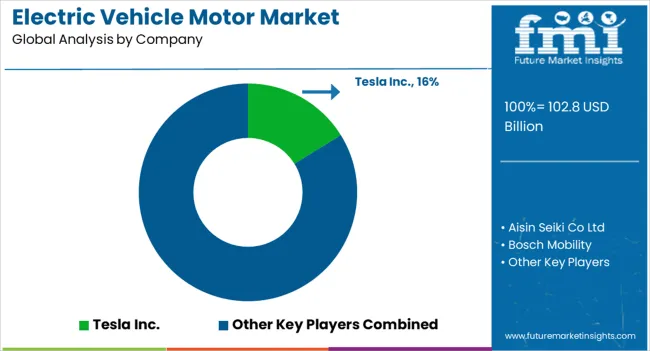
Leading players operating in the global electric motor for electric vehicle market are concentrating on improving the motors' efficiency via research and development. They are also entering into partnerships and collaborations with original equipment manufacturers (OEMs) to improve sales and market holding.
Few OEMs anticipated or planned for BEV domination before the late 2035s, at the earliest, while most OEMs had plans to deploy BEVs three years ago.
Recent Developments in the Global Electric Vehicle Motor Market
Renault and WHYLOT have teamed to deploy axial flux motors in hybrid vehicles starting in 2025.
Western manufacturers have started to lower the amount of rare earth metals used in electric motors. Eastern manufacturers, like Toyota, have developed magnets that use 20 to 50% less neodymium than previous models, although they still employ permanent magnets.
| Attribute | Details |
|---|---|
| Estimated Market Size (2025) | USD 84,995.77 million |
| Projected Market Size (2035) | USD 571,809.04 million |
| Anticipated Growth Rate (2025 to 2035) | 21% |
| Forecast Period | 2025 to 2035 |
| Historical Data Available for | 2020 to 2025 |
| Market Analysis | USD million or billion for Value and Units for Volume |
| Key Regions Covered | North America; Latin America; Europe; Middle East & Africa (MEA); East Asia; South Asia and Oceania |
| Key Countries Covered | United States, Canada, Brazil, Mexico, Germany, Spain, Italy, France, United Kingdom, Russia, China, India, Australia & New Zealand, GCC Countries, and South Africa |
| Key Segments Covered | By Product Type, By Power Capacity, By Electric Vehicle (EV) Type, and By Region |
| Key Companies Profiled | Tesla Inc.; Aisin Seiki Co Ltd; Bosch Mobility; Siemens AG; Nidec Motor Corporation; ABB Ltd; Toshiba Corporation; Magna International; Mitsubishi Electric; Hitachi Astemo; Parker Hannifin Corp.; Delta Electronics Inc.; BYD; Mahle GmBH; Vitesco Technologies |
| Report Coverage | Market Forecast, Company Share Analysis, Competition Intelligence, DROT Analysis, Market Dynamics and Challenges, and Strategic Growth Initiatives |
| Customization & Pricing | Available upon Request |
The global electric vehicle motor market is estimated to be valued at USD 102.8 billion in 2025.
The market size for the electric vehicle motor market is projected to reach USD 691.9 billion by 2035.
The electric vehicle motor market is expected to grow at a 21.0% CAGR between 2025 and 2035.
The key product types in electric vehicle motor market are alternating current (ac) and direct current (dc).
In terms of power capacity, above 200kw segment to command 36.6% share in the electric vehicle motor market in 2025.






Our Research Products

The "Full Research Suite" delivers actionable market intel, deep dives on markets or technologies, so clients act faster, cut risk, and unlock growth.

The Leaderboard benchmarks and ranks top vendors, classifying them as Established Leaders, Leading Challengers, or Disruptors & Challengers.

Locates where complements amplify value and substitutes erode it, forecasting net impact by horizon

We deliver granular, decision-grade intel: market sizing, 5-year forecasts, pricing, adoption, usage, revenue, and operational KPIs—plus competitor tracking, regulation, and value chains—across 60 countries broadly.

Spot the shifts before they hit your P&L. We track inflection points, adoption curves, pricing moves, and ecosystem plays to show where demand is heading, why it is changing, and what to do next across high-growth markets and disruptive tech

Real-time reads of user behavior. We track shifting priorities, perceptions of today’s and next-gen services, and provider experience, then pace how fast tech moves from trial to adoption, blending buyer, consumer, and channel inputs with social signals (#WhySwitch, #UX).

Partner with our analyst team to build a custom report designed around your business priorities. From analysing market trends to assessing competitors or crafting bespoke datasets, we tailor insights to your needs.
Supplier Intelligence
Discovery & Profiling
Capacity & Footprint
Performance & Risk
Compliance & Governance
Commercial Readiness
Who Supplies Whom
Scorecards & Shortlists
Playbooks & Docs
Category Intelligence
Definition & Scope
Demand & Use Cases
Cost Drivers
Market Structure
Supply Chain Map
Trade & Policy
Operating Norms
Deliverables
Buyer Intelligence
Account Basics
Spend & Scope
Procurement Model
Vendor Requirements
Terms & Policies
Entry Strategy
Pain Points & Triggers
Outputs
Pricing Analysis
Benchmarks
Trends
Should-Cost
Indexation
Landed Cost
Commercial Terms
Deliverables
Brand Analysis
Positioning & Value Prop
Share & Presence
Customer Evidence
Go-to-Market
Digital & Reputation
Compliance & Trust
KPIs & Gaps
Outputs
Full Research Suite comprises of:
Market outlook & trends analysis
Interviews & case studies
Strategic recommendations
Vendor profiles & capabilities analysis
5-year forecasts
8 regions and 60+ country-level data splits
Market segment data splits
12 months of continuous data updates
DELIVERED AS:
PDF EXCEL ONLINE
Electric Commercial Vehicle Traction Motor Market Size and Share Forecast Outlook 2025 to 2035
Electric Vehicle Sensor Market Forecast and Outlook 2025 to 2035
Electric Vehicle Battery Conditioners Market Size and Share Forecast Outlook 2025 to 2035
Electric Motor Market Size and Share Forecast Outlook 2025 to 2035
Electric Vehicle Transmission Market Size and Share Forecast Outlook 2025 to 2035
Electric Vehicle Fluid Market Size and Share Forecast Outlook 2025 to 2035
Electric Vehicle E-Axle Market Size and Share Forecast Outlook 2025 to 2035
Electric Vehicle On-Board Charger Market Size and Share Forecast Outlook 2025 to 2035
Electric Vehicle Plastics Market Size and Share Forecast Outlook 2025 to 2035
Electric Vehicle Finance Market Size and Share Forecast Outlook 2025 to 2035
Electric Vehicle Contactor Market Size and Share Forecast Outlook 2025 to 2035
Electric Vehicle Communication Controller Market Size and Share Forecast Outlook 2025 to 2035
Electric Vehicle Charging Cable and Plug Market Size and Share Forecast Outlook 2025 to 2035
Electric Vehicle Battery Formation and Testing Market Size and Share Forecast Outlook 2025 to 2035
Electric Vehicle Range Extender Market Size and Share Forecast Outlook 2025 to 2035
Electric Motors Market Size and Share Forecast Outlook 2025 to 2035
Electric Vehicle Charging Station Market Size and Share Forecast Outlook 2025 to 2035
Electric Vehicle Relays Market Size and Share Forecast Outlook 2025 to 2035
Electric Vehicle DC Contactor Market Size and Share Forecast Outlook 2025 to 2035
Electric Vehicle Test Equipment Market Size and Share Forecast Outlook 2025 to 2035

Thank you!
You will receive an email from our Business Development Manager. Please be sure to check your SPAM/JUNK folder too.
Chat With
MaRIA